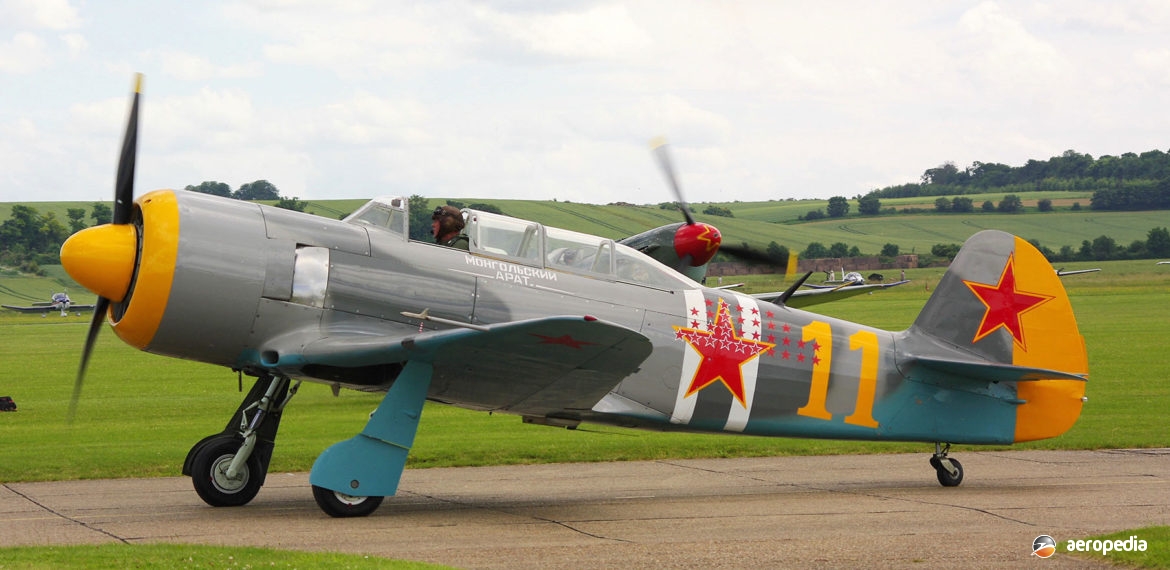Photograph:
Yakovlev Yak 11 25-III-08 at Duxford, United Kingdom in 2012 (David C Eyre)
Country of origin:
Union of Soviet Socialist Republics
Description:
Two-seat intermediate military trainer
Power Plant:
One 507 kw (680 hp) Shvetsov Ash-21 seven-cylinder air-cooled radial engine
Specifications:
- Wingspan: 9.4 m (30 ft 10 in)
- Length: 8.5 m (27 ft 10¾ in)
- Height: 3.28 m (10 ft 9 in)
- Wing area: 15.4 m² (165.6 sq ft)
- Max speed at sea level: 424 km/h (263 mph)
- Max speed at 2,250 m (7,380 ft): 460 km/h (285 mph)
- Economical cruising speed at 1,707 m (5,600 ft): 323 km/h (205 mph)
- Initial rate of climb: 540 m/min (1,722 ft/min)
- Service ceiling: 7,100 m (23,290 ft)
- Range: 1,290 km (800 miles)
- Take-off run: 470 m (1,542 ft)
- Landing run: 500 m (1,640 ft)
- Empty weight: 1,900 kg (4,190 lb)
- Useful load: 644 kg (1,419 lb)
- Loaded weight: 2,400 kg (5,290 lb)
Armament:
One 12.7 mm (0.50 in) UBS machine gun and provision for two 50 kg (110 lb) practice bombs
History:
The Yakovlev Yak 11 (known to NATO as Moose) began to enter service with the Soviet Airforce in 1947 and bore some resemblance to the designer’s, Aleksandr Yakovlev, wartime fighter designs, the wing, tail assembly, and undercarriage being similar to those of the Yak 9 single-seat fighter. A sprightly performer, the Yak 11 held a number of FAI homologated records, including the 500 km (310.69 miles) closed circuit record at 471.33km/h (292.88 mph); the 1,000 km (621.38 miles) closed circuit record at 442.17 km/h (274.76 mph); the 2,000 km (1,242.77 miles) closed circuit record at 359.98 km (223.69 mph); and a distance record in a straight line of 1,990.12 km (1,236.64 miles).
Construction was of all metal, the armament of one machine gun being fitted on top of the portside of the engine cowling. The Yak 11U was a variant with a nosewheel undercarriage. Production totalled 3,850 aircraft, and a further 707 were licence-built in Czechoslovakia by LET at its plant at Kunovice. The Czech plant also licence-built the Ash-21 engine, it becoming known as the M-21. The first C 11 flew in October 1953 and was in production for three years.
The Yak 11 was supplied to the air forces of Albania, Austria, Afghanistan, Bulgaria, China, Czechoslovakia, Egypt, Hungary, Poland, Romania, Syria, Yemen and, of course, the USSR. With the exception of the North American T-6 Texan, the Yak 11 was probably the most widely used two-seat high-performance training monoplane in the world. It is believed to have flown in prototype form in 1946, and the fact it was in production for the Soviet Air Force was not known to the west until March 1948 when a Russian pilot crash-landed an example in Turkey on a delivery flight from Zaporozhe in the Ukraine.
The Yak 11 was produced with both tailwheel and nosewheel undercarriage configurations, the latter being known as the Yak 11U and having a slightly lengthened fuselage. As with most Soviet designs, pneumatics formed an integral part of the undercarriage, flaps and engine starting systems and they were fed from a pressure bottle operating at 4,964 kPa (720 lbs/sq in) supplied by an engine driven compressor. Fuel was carried in two tanks in the inner wings, each holding 173 litres (38 Imp gals).
In recent years the type has proved popular with warbird enthusiasts in the west, examples being obtained from China, Egypt, Russia and Romania after their retirement. These have found their way on to the civil registers of the United States, Great Britain, and France. A couple in the United States have been converted for pylon racing and these conversions have included the installation of 895 kw (1,200 hp) Pratt & Whitney R-1830, 1,119 kw (1,500 hp) Pratt & Whitney R-2000-D4, Pratt & Whitney R-2800, and Wright R-3350 engines. Others have been fitted with Allison V-12 in-line engines and single cockpits to convert them to Yak 3 fighter configuration and, to help with maintenance, American owners have re-designed the undercarriage to accept Cessna 421 wheels and hydraulically-operated Cleveland disk brakes.
A number of attempts have been made since 1990 to import a couple of examples to this region but have failed. In late 1997 an example arrived in New Zealand and restoration commenced towards airworthiness at Blenheim. This aircraft was one of 41 recovered from Egypt in 1984 and was a LET C 11 licence-built in Czechoslovakia. The restoration is not known to have been completed and it is believed to have been exported.
Another has been exchanged with a museum in Czechoslovakia, a CAC CA-27 Sabre restored for display for that museum being swapped for a Yak 11 and a MiG 23, the latter going to the United States. This Yak 11 commenced restoration in Western Australia with Panama Jack’s Aircraft Co at Jandakot, WA and the registration VH-YII (c/n 171525) was allotted. However, on 20 December 2007 the incomplete project was exported.
A total of 53 Yak 11s is known to exist, all but one or two coming from the Czech production line.

